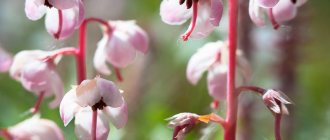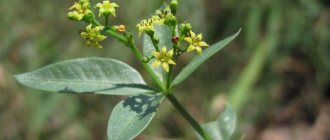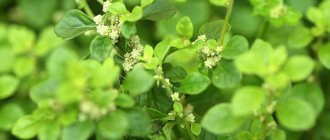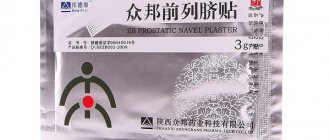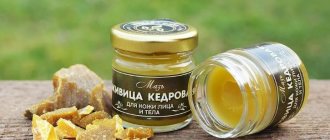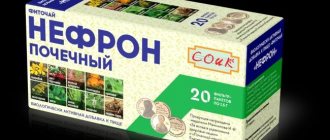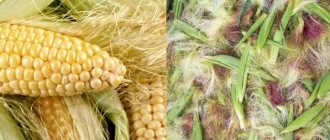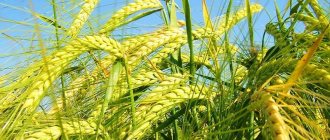Nature is rich in various useful medicinal plants, which can independently develop and reproduce in the numerous fields and forests of our homeland. One of such medicinal representatives of the world of flora is mullein - a herbaceous plant of the Norichinaceae family.
What kind of culture is this? What is its habitat? What properties does it have? And how is it used in medicine? Let's find out.
Botanical species
Despite the fact that mullein (or bear's ear, or royal scepter) is a wild herb, its appearance, especially during the flowering period, is very attractive.
The stem of the plant is single, erect, densely covered with downy, ashy hairs. The pointed leaves of common mullein are fifteen to thirty centimeters long and five to ten centimeters wide. They grow along the entire stem, proudly rushing upward.
Typically, the Royal Scepter blooms with a thick, spike-shaped inflorescence in the shape of a cylindrical brush.
However, the description of the common mullein would be superficial if we focused only on the characteristics listed above. The most beautiful thing about this plant is its flowers, crowned with a straight, long stem, the height of which can vary from fifty centimeters to three meters.
Bear ears: plant description
The plant called bear's ear is often better known as bearberry.
An evergreen perennial shrub spreads along the ground, barely growing to thirty centimeters in height. You can recognize it by its branching and oblong, rich green leaves, similar in shape to an elongated egg, which seem to frame the plant from above. The plant blooms in late spring and blooms light pink until mid-summer. Fruiting of the bush begins at the end of summer. Bearberry fruits have a scarlet color, mealy pulp and five seeds each. Bearberry can be found in nature in Canada, North America and the northern part of Eurasia. In Russia, bearberry grows in the Far East and throughout Siberia; a small amount is distributed in the Caucasus. The plant settles in forests, mainly deciduous or pine. It is also found on rocky, open slopes. Loves dryness and plenty of light. It does not live in close proximity to plants of another species, so it is impossible to find bear ear bushes in thickets or dense green meadows.
It's time to bloom
The common mullein flower has a bright yellow color. It is very small and delicate in appearance. Here is its structure:
- bract (has a pointed shape in the form of a lancet);
- peduncle (thick and short, attached to the solid axis of the inflorescence);
- calyx (has pointed lobes converging at the base);
- corolla (fifteen to twenty millimeters in diameter, yellow);
- stamen (there are only five of them, the front two are slightly thicker and longer than the others);
- pestle (in the form of short thin threads).
The royal scepter begins to bloom from the second year of life.
Cuff: medicinal properties
The effect of this herb can be on several functions:
1. For women
- Helps relieve symptoms of menopause and PMS.
- Normalizes the menstrual cycle, eliminates uterine bleeding.
- Eliminates endometriosis, prevents the formation of fibroids, ovarian cysts, and malignant tumors.
- Helps in the treatment of infertility.
- Recommended for the treatment of thrush.
2. For the treatment of the cardiovascular system
- Helps normalize blood pressure.
- Reduces the risk of heart attacks and strokes.
- Reduces bad cholesterol levels.
- Normalizes the tone of veins, capillaries, arteries, improves blood flow, fights varicose veins.
3. In case of intoxication of the body
- Promotes the removal of salts, heavy metals, free radicals, radionuclides.
- Improves the cleansing and excretory function of the liver.
4. For the treatment of the respiratory system
- Recommended for laryngitis, pneumonia, bronchitis, pulmonary tuberculosis.
5. For the digestive system
- Recommended for ulcerative lesions of the gastrointestinal mucosa, cholecystitis, colitis, diarrhea, decreased intestinal motility.
6. For the treatment of skin diseases
- Recommended for eczema, burns, difficult-to-heal wounds, acne, purulent rashes.
Use of herbs for medicinal purposes
Chemical composition
As mentioned above, mullein is a plant often used for medicinal purposes. Therefore, its chemical composition is very rich in all kinds of useful microelements.
These include: tannins, saponins, beta-carotene, sugars, ascorbic acid, essential oils, fatty oils, alkaloids, iridoids, glycosides, harpagide, arcubine, catalpol, coumarins, phenolcarboxylic acids.
The elements listed above have a positive effect on various organs and systems of the human body. They are easily extracted from the plant itself and can be used in the manufacture of pharmacological agents.
What does a bear's ear help with? What effective means of using it exist?
Contraindications
The bear's ears plant has contraindications that must be taken into account during treatment.
Bearberry should not be used:
- at all stages of pregnancy. The reason is that this herb affects the muscles of the uterus, causing severe irritation. This may lead to termination of pregnancy.
- for glomerulonephritis – it has an irritating effect on the kidneys, which slows down the healing process. Also, failure to follow the rules for taking medicinal herbs can provoke vomiting, cause nausea and intestinal upset.
- children under twelve years of age. This is due to the increased sensitivity of the child’s body to the medicinal composition of the plant.
- In some cases, bearberry causes individual intolerance!
- Due to the high content of tannins, the plant causes irritation, and you should not get carried away with frequent use of this herb.
Diseases and conditions
For example, it is quite possible to cure the initial stage of urolithiasis with mullein enzymes. Such important elements of the plant as saponins have a diuretic effect on the body and remove small stones and sand, and essential oils and iridoids reduce inflammatory processes and protect against infectious damage to the mucous membrane.
Cystitis (like other inflammatory diseases of the bladder) can also be cured using drugs based on this plant. The medicinal properties of common mullein lie in the action of enzymes such as essential oils, iridoids, acids and potassium. They relieve inflammation and act as pain relievers.
Bear ear can also deal with swelling easily. Thanks to saponins and its other components, the plant is able to remove all excess fluid from the human body.
Bronchitis, pneumonia and even asthma are quite amenable to adjustment with drugs based on the components of the royal scepter. First of all, these are mucus, saponins, essential oils, organic acids. They relieve inflammation of the respiratory system, cleanse the lungs, thin mucus and promote its removal from the body.
Thanks to elements such as saponins and iridoids, mullein is able to prevent the proliferation of cancer cells and even eliminate them.
Diseases associated with the nervous system (stress, overexcitation, depression, insomnia, neuroses) can also be treated with this herb. Saponins, flavonoids, ascorbic acid, alkaloids and magnesium, which are part of the plant, soothe and improve the functioning of the central nervous system. In complex therapy, they can even help in the fight against seizures and epilepsy.
Diseases of the joints, muscles and bone tissue are also effectively treated with bear's ear components such as flavonoids, calcium and magnesium, which strengthen bones, improve joint mobility and elasticity of connective tissues, restore damaged nerve fibers, etc.
Cardiovascular diseases can be effectively corrected with drugs that contain the active ingredients of mullein. These are flavonoids, essential oils, coumarins, alkaloids, ash, potassium, calcium, magnesium, which strengthen the heart and blood vessels, cleanse capillaries, lower blood pressure, and reduce blood clotting.
The royal scepter also helps with purulent wounds, ulcers, burns and other serious damage to the skin. Thanks to the action of coumarins, iridoids, organic acids, tannins and other elements, it is possible to get rid of bacterial and viral infections, so that wounds can cleanse and heal.
Using a bear's ear, you can completely recover from such a serious disease as hemorrhoids. Plant extracts help reduce painful formation and reduce inflammatory processes.
As you can see, the range of uses of common mullein in medicine is very wide and specific. How can you cure certain diseases at home?
Indications for use
Bear's ear is a herb that can be used for therapeutic purposes for diagnosed diseases:
- The urinary system - irritates the internal soft tissues of the kidneys, causing an acceleration of urine output. Suppresses pathogenic microorganisms and normalizes water-salt balance. It is used for diseases such as pyelitis, pyelonephritis, urethritis, cystitis, and renal failure.
- Nervous system – promotes relaxation, relieves agitation, relieves insomnia, has a beneficial effect on neuroses and neurological disorders.
- Digestive tract - recommended for loose stools and various inflammations of the mucous membrane in the stomach. Removes toxins in case of poisoning.
- Skin problems - when scrofula is detected, with wounds that have not healed for a long time, festering.
The product is recommended for treatment of beer alcoholism. For men, decoctions and infusions help cope with chronic and non-infectious prostatitis.
The herb helps relieve painful discomfort during urination.
For women, a product made from herbs also has a positive effect on the genitourinary system. It is used both internally and externally in the form of douching. For infections of the genital tract and sexually transmitted diseases, bearberry infusions are used in combination with medications. After labor, gynecologists recommend for women to contract the muscles of the uterus.
ethnoscience
Here are the types in which this plant is recommended to be used:
- Decoction. One tablespoon of dried bear ear leaves is poured with 250 milliliters of water and boiled for two minutes. Then they let it brew for half an hour and filter. Take one tablespoon orally three times a day.
Helps with ailments such as cystitis, atherosclerosis, tonsillitis, stomatitis, neuralgia, hypertension, and is used externally to treat skin diseases. - Infusion. Pour ten grams of the dry mixture with a glass of boiling water and leave for fifteen minutes. Strain and take 150 milliliters three times a day after meals. Use as a remedy for diseases such as colds and respiratory diseases, asthma, tuberculosis, pneumonia, epilepsy, whooping cough, shortness of breath, and gastrointestinal diseases. For hemorrhoids, it is recommended to add it to water during sitz baths.
- Tincture. One tablespoon of dried flowers is poured with 150 grams of vodka, infused for three to five days and used as a rub for arthritis, radiculitis, neuralgia, and rheumatism.
- Oil. Pour three tablespoons of mullein flowers into one hundred milliliters of olive oil (you can take refined sunflower oil), place in direct sunlight and leave for four weeks, shaking the container once every twenty-four hours. Then strain the product and put it in the refrigerator.
Use as a lotion for eczema, boils, ear pain, wounds and injuries. - Ointment. Grind mullein seeds, mix with butter (in a ratio of one to two) and use for festering wounds and ulcers.
So, we learned what diseases the royal scepter treats and how to use it. Now let's take a look at the tips and tricks for collecting and storing the plant.
Collection, preparation, storage of cuffs
You can start collecting the green part of the grass at the end of May and until the end of September. Some traditional healers also use the roots of the plant, which can be dug up at the end of September.
It is better to collect in the daytime after the dew has dried on the branches of the plant. The entire above-ground part is cut off, and the roots are dug out with a shovel. The green part must be sorted out well, and any spoiled leaves and twigs must be discarded. Wash the roots to remove dirt.
The grass can be hung in bunches or laid out on a flat surface in a dark place. To speed up the process, it is recommended to use electric dryers.
The roots are laid out in an even layer in a dark place, preferably in the attic under a metal roof. For good drying of the grass and roots, in addition to heat, you also need good ventilation, otherwise all the raw materials will simply become damp.
After drying, place all raw materials in cotton bags. The herb is stored for about a year, then it begins to taste bitter. Should be stored in a dry, well-ventilated place.
Pharmacy cuff
